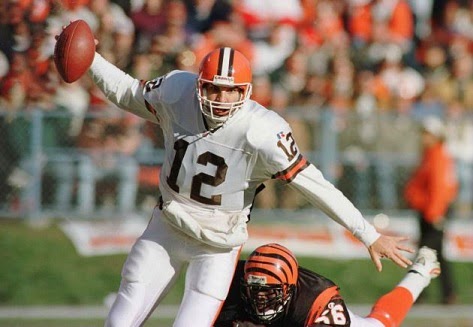On March 31, 1993 free agent QB Vinny Testaverde,
previously with the Tampa Bay Buccaneers, signed a one-year contract with the
Cleveland Browns. He was to back up Bernie Kosar, a quarterback he had understudied
at the University of Miami nearly a decade before. At 29, Testaverde and Kosar
were the same age (in fact, their birthdays were just 12 days apart – the
studious Kosar graduated from college a year early and Testaverde entered late).
“Cleveland wanted me, Tampa would have settled for me,”
said Testaverde in discussing his decision. The Bucs had reportedly offered a
deal to Pittsburgh QB Neil O’Donnell prior to Testaverde choosing to go with
Cleveland (O’Donnell remained with the Steelers and Tampa Bay ended up going
with Craig Erickson, a rookie backup in ’92 who was also a product of Miami).
“Being back on the same team, playing the role I did in
college, I feel comfortable with it,” Testaverde added. “We have a good
relationship, Bernie and I do, and I think that will make it more fun than it
has been for me in the past few years.”
Cleveland Head Coach Bill Belichick welcomed the depth
that his new quarterback brought to the position. The Browns ran into trouble in ’92
when Kosar and backup Todd Philcox were both injured. Former Bears QB Mike
Tomczak had been signed to fill in, but the team lost six of its last nine
games to finish with a 7-9 record.
Testaverde had won the 1986 Heisman Trophy and Tampa Bay
made him the first overall pick in the ’87 NFL draft. With his outstanding
physical tools, at 6’5” and 235 pounds and including a strong arm, expectations
were high for him, but his six seasons were filled with adversity. He took over
as the starting quarterback late in the strike-interrupted 1987 season and
proceeded to lead the league in interceptions thrown over the course of the
next two years, including 35 in 1988, still the second-highest total in NFL/AFL
history.
While he could be a precise passer and was fairly mobile,
Testaverde also tended to deal poorly with adversity and could make bad plays
as a result. He left the Buccaneers as the team’s all-time leader with 14,820 passing
yards. However, Tampa Bay went 24-48 with him as the starting quarterback.
While mediocre coaching and lack of a strong supporting cast certainly played a
role, Testaverde drew criticism regarding his work ethic and toughness under
pressure. In many ways, he was the exact opposite of Kosar, who overachieved
with less impressive skills and had great intelligence and leadership ability.
As anticipated, Kosar started the ‘93 season but
struggled and Testaverde performed ably in relief outings. The Browns had a 5-3
record when Coach Belichick, in a stunning decision, released Kosar – all the
more surprising because Testaverde was injured and Philcox had to step into the
lineup for four games (three of them losses on the way to another 7-9 record).
When Testaverde returned, he continued to play well and
had his best pro season to date, throwing more touchdowns (14) than
interceptions (9) for the first time and compiling an 85.7 passer rating. His
91.3 completion percentage on a 21-of-23 performance against the Rams was a NFL
record at the time. He was rewarded with a contract extension and the starting
job for ’94.
In 1994, the gamble appeared to pay off when the Browns
went 11-5 and reached the playoffs. Still, operating behind an offensive line
that allowed only 14 sacks, Testaverde reverted to form with a negative TD
pass-to-interception ratio of 16 to 18 and was especially unimpressive in
fourth quarter pressure situations. But he was a winning quarterback in his
first postseason game and drew praise for development as a leader.
Hopes for further improvement in 1995 were dashed when
the team fell to 5-11 after getting off to a 3-1 start. The announced move of
the franchise to Baltimore for ’96 was a significant distraction, but
Testaverde continued to have difficulty with consistency. While he gave up only
10 interceptions, tossing 17 touchdown passes, he was also benched for three
games in favor of backup Eric Zeier.
The team, now called the Baltimore Ravens, had a new
offensive-minded head coach in Ted Marchibroda for 1996 and Testaverde put up
big numbers, including 4177 yards and 33 TD passes, and was named to the Pro
Bowl for the first time. But the record was only 4-12 and, after a lesser
performance in ’97, Testaverde was let go.
In five seasons with the Browns and Ravens, Testaverde
threw for 14,403 yards and 98 touchdowns while giving up 71 interceptions. It
was improvement, to be sure, but the inconsistency remained and only once
during that period did the team finish with a winning record.
Testaverde went on to have an outstanding year with the
New York Jets in 1998, followed by a season in which he went down for the year
in the opening week and then a 2000 campaign where he led the NFL in
interceptions for the fourth time. His career would ultimately come to an end
in 2007 at age 44, and while there were many accomplishments, there was also the
up-and-down pattern of performance that caused Testaverde’s failure to achieve
the heights that were anticipated when he came into the league in 1987.
